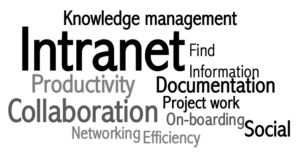An intranet is basically a small but powerful version of the internet.
The articles published in our Intranet Special provide some insight into intranets. You can read about intranet trends, the path from the Intranet 1.0 to the modern intranet, and about intranet objectives in general. Until this post, this collection of articles has ignored the question what an intranet really is.
Why even ask, when many seem to understand:
An intranet consists some pages that I can open in my browser and can see only within my company or organization.
But honestly, that’s not even half the truth.
An intranet
According to the English Wikipedia definition, an intranet is:
A private network accessible only to an organizations’ staff.
Access to an intranet was traditionally granted through a hardware system located inside of a company. That has been changing. Many sales representatives or other employees can access their organizations's intranet remotely from their personal computers or mobile devices. By now, many employees have access through their own devices (Bring Your Own Device – BYOD). In some cases, even third parties like clients, sales partners or suppliers can get access to parts of the intranet (see extranet).
The same technologies and procedures are being applied for almost all intranets. An intranet is nothing different than a small internet, only that access is restricted to staff and maybe third parties. As the same technology and features are implemented, no new development of fundamental principles is needed. Employees can work with the same familiar program (like a browser) for the company's intranet and the internet.
The internet
The internet, on the other hand, is defined by Wikipedia as follows:
The internet is the global system of interconnected computer networks that use the Internet protocol suite (TCP/IP) to link billions of devices worldwide. It is a network of networks that consists of millions of private, public, academic, business, and government networks of local to global scope, linked by a broad array of electronic, wireless, and optical networking technologies.
To assure that those ‘billions of devices worldwide’ can understand each other, they need to communicate via certain protocols. The devices access the respective protocols for specific purposes. To help structure those protocols, when the internet was founded, the so-called Department of Defense (DoD) model (Internet protocol suite) was developed. The model isolates the different management and communication layers, for example, when devices don’t need to use a protocol used by other layers.
Layers and protocols
From lowest to highest, these are the four abstraction layers used by the Department of Defense (DoD) model:
- Link layer: that’s the group of methods and communication protocols that the host is physically connected to. It’s the hardware, like cables, and the methods of transmitting bits through them, e.g. via ethernet. This layer assures that the bits are being routed and received securely (preventing and eliminating the loss of data/encryption).
- Internet layer: assures address allocation for the hardware in use. Specifies the destination of the data (e.g. a router).
- Transport layer: data packages are divided into individual segments, handling host-to-host communication. Prevents errors during transport.
- Application layer: provides functions for data exchange of applications, including data input and output. For a deeper explanation, also see the OSI-model.
Now it’s going to get exciting: regular users can only see the application layer. A user uses his device (e.g. computer, tablet, smartphone, smartwatch) to accesses an application. This application communicates with applications on other devices (e.g. a server or another computer) via a certain protocol. Only if the different applications are using the same protocol, can the user see or hear something on his device (through the display or speakers). Then he can react or respond.
In many cases, the user can’t see the protocol used for the communication between applications. When a user opens a page in the internet or in an intranet (e.g., with Chrome, Firefox, Internet Explorer or Edge), he can however recognize the protocol used. The address in the browser's address field starts with “http” or “https”. “Http” stands for Hypertext Transfer Protocol, “https” is the secure variety of that, Hypertext Transfer Protocol Secure. The user's browser communicates via “http” with a server in the internet or intranet, which transmits the page. The browser then displays the page. When the user enters something, the browser transmits that information to the server. The browser doesn’t need to know anything at this stage about segments, packages, routers or ethernet.
Simplified, an address like http://www.our-intranet.de/healthyfood/mealplan, could look like this in a browser application:
PROTOCOL://SERVER.TOPLEVEL.DOMAIN/PATH/PAGE
Neither the user nor the browser, need to actually know the physical server address. The lower layers also ensure that the right server will be activated, even so, a server with the same address might exist somewhere on the internet. All a user and the applications need to know, is the internet or intranet address. A user usually doesn’t need to know the protocol or which server is used. The lower layers can be configured in a way so that requests or transmissions from a certain application will automatically be transported to the correct address.
Intranet requirements
All an intranet really needs is:
• Internet technology with its respective layers and protocol.
• Suitable devices with appropriate applications.
• A customized configuration for the individual company.
By using this infrastructure, an intranet will be able to do everything that the internet can do.
If a user would like to send an email to another user, and the company has provided the corresponding infrastructure, all the user has to do is start the application. Then he simply writes the message and the address of the other user (or takes it from the address book):
NAME@TOPLEVEL.DOMAIN
The user doesn't need to know the protocol (Simple Mail Transfer Protocol), the server, and other details.
An intranet functions just like the internet
… you can use internet services like www, email, telnet, Usenet and FTP. Any computer can be connected to any other. The data transfer between the connected computers is based on technically standardized internet protocols.
Many companies have replaced their ISDN systems with voice over Internet Protocol systems (also known as Voice over IP, VoIP and IP telephony). The desk phone, the headset, the software on a computer, and a smartphone app use corresponding protocols, like SIP (or proprietary protocols, like the one Skype uses). These establish a connection and let the user make a phone call via the company's intranet or the internet. The configuration of the intranet automatically recognizes, whether the connection has been established inside the same building, or whether it comes encrypted via the internet, maybe from an overseas location. The user simply needs the program or application, and the address of the conversation partner (for example “+49 1234 56789” or for SIP “NAME@TOPLEVEL.DOMAIN“).
That makes an intranet not only the browser, but also the telephone and video conference system, the instant messaging program, the app for chatting, among other things the company might be using.
The next time you see a headline like “Leave the old email system, get into the intranet”, you may want to tell the author that email is part of an intranet and that it is just a matter of using the right tools (aka applications).
The original article "Was ist eigentlich ein Intranet?" was published in German by Frank Hamm.
Frank Hamm is a consultant for communication and collaboration who supports companies in their digital transformation. He has written for INJELEA-Blog about social business, intranets, enterprise 2.0 and company communication practices since 2005. Frank is an avowed nexialist and writes about this at Der Schreibende.
is a consultant for communication and collaboration who supports companies in their digital transformation. He has written for INJELEA-Blog about social business, intranets, enterprise 2.0 and company communication practices since 2005. Frank is an avowed nexialist and writes about this at Der Schreibende.
You can find more articles by Frank Hamm in our intranet special.



